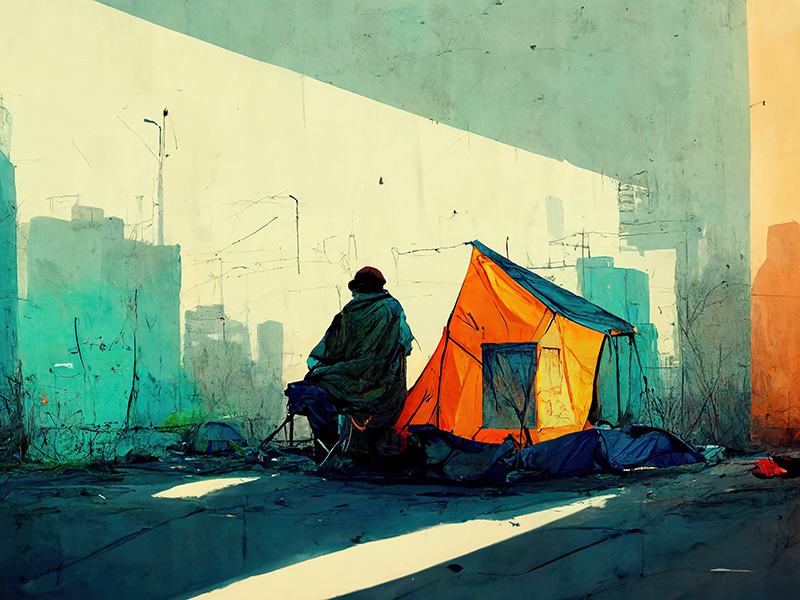Injustice of the Unhoused
A History of Homelessness

From Compassion to Contempt?
By Donald Whitehead
Homelessness in one form or another has been with us since the founding of this country—from displaced indigenous peoples to immigrants who couldn’t quite find a way to make it in the new world. And in every era of our history, we have made choices as a nation about how we would respond to those in need.
There have been distinct periods of homeless in America, according to historians. When first used in the United States in the 1870s, the term “homeless” was used to describe itinerant tramps who traversed the country in search of work. Prior to that time, most Americans had lived in rural areas, farming or working in skilled trades, but the Industrial Revolution lured many to the country’s growing cities with the promise of jobs with regular wages.
World War II acted as an economic engine that put the nation to work. Over the ensuing three decades, the typical individual experiencing homelessness continued to be disproportionately white and male, but became increasingly older (usually over 50 years old), disabled, and dependent on welfare or social security. They usually resided in cheap hotels, flophouses, and single room occupancy hotels (SROs) located in the poorest areas of urban America. (Peter Rossi; Down and Out in America: The Origins of Homelessness)
Most periods of homelessness have been mitigated by robust responses from the federal government, including the Housing Act of 1937 and other resources created by the New Deal, Social Security, and the Civil Rights Act. While these programs had their flaws and many were in some ways discriminatory, they played a significant role in reducing homelessness. The common thread in these responses was a dramatic increase in resources to address structural issues.
The first federal legislation enacted to explicitly address homelessness was the Stewart B. McKinney Homeless Assistance Act, drafted by the National Coalition for the Homeless, which was signed into law in 1987. In addition to defining homelessness, which is important for allocating federal resources, it also made provisions for using federal money to support shelters for persons experiencing homelessness. The McKinney Act also created a targeted Health Care for the Homeless (HCH) primary care funding stream, with a distinct broad definition of homelessness, which now exists within the Federally Qualified Health Center (FQHC). The McKinney Act served as the primary source of funding for homeless programs for decades.
The McKinney Act also authorized the creation of the U.S. Interagency Council on Homelessness (USICH). USICH is an independent executive branch body established to better coordinate homelessness programs across government agencies. USICH includes representative membership from all major federal agencies whose mission touches upon homelessness— including, among others, HHS, HUD, the Department of Veterans Affairs (VA), and the Federal Emergency Management Agency (FEMA).
Many are not aware that some housing advocates initially advocated for a more structural response to the crisis of homelessness: The Homeless Persons’ Survival Act. This initial act was significantly scaled back and introduced as the McKinney Act. In a similar fashion, advocates made a second attempt for structural change 13 years later, in the early 2000s, but the movement never really gained traction due to lack of support from Congress and the advocacy community.
In 2002, USICH spearheaded the Chronic Homelessness Initiative, asking states and local jurisdictions to create 10-year plans to end chronic homelessness. Another change in federal policy occurred in 2003, bringing a focus on “ending chronic homelessness” through low-threshold and permanent supportive housing programs (HUD, 2007a). At that time, through a collaborative process overseen by USICH, the federal government formally defined chronic homelessness as “an unaccompanied homeless individual with a disabling condition who has either been continuously homeless for a year or more or has had at least four episodes of homelessness in the past three years” (HUD, 2007a, p. 3).
The National Coalition for the Homeless was one of the few agencies that expressed concern about the paradigm shift. They felt the term “chronic homelessness” was yet another stigmatizing label—a code word for individuals who are deemed to merit attention and resources because they fit preconceived notions of homelessness. They also believed the initiative enabled policymakers to disconnect the issue of homelessness from the acute lack of affordable housing and poverty that underlie it. The “chronic homelessness” initiative collapses a wide range of experiences of people who lack housing into a singular, monolithic category, creating a false hierarchy of need based on resource allotment, not the structural underpinnings of homelessness itself. Thus, what is truly “chronic” about homelessness is the lack of political will to address its root causes. For millions of Americans, this chronic political inaction results in homelessness—the most abject form of poverty and deprivation—in the land of plenty.
The next reauthorization of the McKinney-Vento Act, called the HEARTH Act, was signed into law in 2009. In 2010, under President Obama’s administration, a federal strategic plan to end homelessness was released (USICH, 2017). The federal strategic plan established four key goals: (1) Prevent and end homelessness among veterans in five years; (2) Finish the job of ending chronic homelessness in seven years; (3) Prevent and end homelessness for families, youth, and children in 10 years; and (4) Set a path to ending all types of homelessness.
Fast-forward to 2023. As we embrace the challenges of modern homelessness, we are confronted with a new phenomenon. Instead of responding to increasing homelessness with compassion, we have seen a trend of outright attacks on people on the streets. There is contempt. There is vilification of people in ways that we are still struggling to address and fully comprehend. There is little understanding that people experiencing homelessness are often the victims of criminalization patterns, scorn, and community outrage.
We have reached an inflection point, with some communities, like the state of Tennessee, going so far as to make camping on public property a felony criminal activity. In Missouri, legislators have outlawed proven programs like permanent supportive housing. In Miami, legislators want people experiencing homelessness to be shipped to an island that also houses a hazardous waste burning facility.
Most people have a hard time believing these measures are real in a modern, civilized society, but they are very real. And the reality that elected officials believe these myopic and cruel strategies are the best solutions for those whose crime is not being able to afford a place to live is unfathomable.
Even more troubling is the fact that these draconian laws are being enacted in both conservative and progressive communities. For example, a group of hedge fund millionaires is leading the charge against the homeless by offering model legislation that supports criminalization and forced institutionalization. This group, the Cicero Institute, has been linked to private prison funding and an anti-immigration stance in the past. It is disheartening that many members of the faith-based community are following their lead. I struggle to find a religious doctrine that espouses contempt for the poor or disabled.
Homelessness is a justice issue. All Americans should have a right to housing. We have the necessary resources, but our country is stuck in a zero-sum game of believing that by helping those who have been cast off by society, we will somehow lose some of our own status or material wealth. Instead of falling into the trap of demonizing those experiencing homelessness and implementing failed policies, we should lead with compassion and implement structural solutions to end homelessness for good.
With more than 25 years as an advocate, Donald Hugh Whitehead Jr. currently serves as the Executive Director of the National Coalition for the Homeless and is recognized as a leading expert on homelessness. He served two terms as president of the board of directors for the National Coalition for the Homeless, two terms on the board of directors for Faces & Voices of Recovery, and two terms with the National Center for Cultural Competence.

